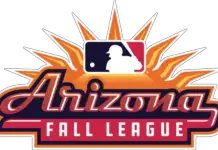10. Brenan Hanifee 50
11. Hanifee is a plus athlete on the mound with a clean, low effort delivery. He gets great extension and his FB plays above its velocity. The FB velocity has ticked up, and he now sits 92-94mph, t96 with heavy sink. It flattens out up in the zone, but it’ll miss bats when located in or out. He is working on a slider, curveball, and changeup. None are ready for showtime yet, but the slider flashes above average and should be a consistent above average pitch eventually. Control is very advanced for a 20-year-old, and command projects to above average. Hanifee’s future role will be determined by the development of his offspeed pitches, he has significant upside but his profile is still based mostly on projection which limits him to this position.
12. Dean Kremer 50
The second piece of the Manny Machado return, Dean Kremer is a tall, lean right handed starting pitcher. He’s split time between starting and the bullpen in the Dodger’s organization but has really taken a huge leap forward as a starter this year. Kremer has a simple, athletic delivery with a standard high ¾ arm slot. His fastball has been up to 97mph in the pen but is more in the 91-93 t95 as a starter. The fastball lacks much horizontal movement, but it has excellent ride up in the zone and seems to play above its velocity no matter where it’s located. It reminds me of a RH version of Wei-Yin Chen’s FB. Kremer’s second-best pitch is his curveball, it’s a low 70s big breaker that he’s very comfortable with. He uses it against batters on either side of the plate and can locate it for strikes and drop it for swings. He also has a slider in the mid-80s and a changeup. The changeup has nice tailing action, but it doesn’t seem like he’s very comfortable throwing it. The slider is ok, but is too similar to the curveball in break, it lacks the glove-side run or tight late break necessary to be weapon. The pitch mix plays well and if he can improve upon his inconsistent command he looks like a rotation piece with a mid-rotation ceiling.
13. Zac Lowther 50
No real change in the profile from last year, just more confidence due to performance. Lowther has a deceptive delivery and gets excellent extension. Both allow his stuff to play up. The stuff is ok, FB t93-94, but usually 89-91 with late tailing action. His breaking ball is a slurvy thing that he commands very well and plays like an above average pitch despite the lack of wipeout movement. He also offers a changeup that looks to be an average pitch, but the consistency isn’t quite there yet. After dominating Low A, Lowther is being tested by more patient A+ hitters. I still think the real test will be AA, and he’ll need to improve his FB command which lags behind the command of his breaking ball. If he can, he’ll be a backend rotation piece sooner rather than later.
14. DJ Stewart 45
Stewart’s AAA performance hasn’t set the world on fire, but he’s put up a solid line in the notoriously pitcher friendly Harbor Park. He’s played some in RF and although he doesn’t look as comfortable as in LF, but he has thrown well from RF that he could fill in a game or two there without hurting you. He’s a relatively low ceiling guy, it’s hard to see him being much more than an average corner OF, but he’s also has a high floor. His patience and LH pop should amount to at least a second division regular. This floor and proximity to the majors is the reason why he’s ranked this highly.
15. Blaine Knight 45
An unflappable competitor who has performed in the toughest conference in college baseball. Knight is a tall, very thin RHP with a loose arm and an athletic delivery. He has a strong four pitch mix and good control. His fastball can t97, but he’s usually more in the 90-94 range. The offspeed stuff includes a mid-80s slider that could be an above average pitch, a softer curve, and a changeup that flashes but lacks consistency. I think there is potential for average command, but right now he looks like he has trouble locating down in the zone. Despite going undefeated this season and having legit stuff, he gave up an awful lot of home runs. He gives up more hard contact than you’d expect. I’d place the blame on inconsistent stuff and trouble locating pitches off the plate, he almost throws too many strikes. The real question here is can Knight add weight to his frame and hold the mid-90s? If so, there is mid-rotation upside. He’s got a fairly high floor too, if he doesn’t cut it as a starter, it’s hard to see him not being able to help a MLB team as a FB/SL reliever.
16. Cody Carroll 45
Carroll is the underrated second piece in the Britton deal, he’s a near-ready bullpen piece with a fastball that has touched 101mph and a plus slider. He has decent control and will throw strikes but has trouble hitting his spots. He’s already 25 years old, so it’s tough to project a lot of improvement, but even as is, he looks like a 7th inning type relief arm. He has some deception in his delivery and is athletic for a tall pitcher, so maybe there is a little more command there going forward, if so he has closer upside.
17. Rylan Bannon 45
A piece in the Manny Machado deal, Rylan Bannon is a guy I’ve had my eye on for a while now. I thought he was a guy the Orioles should target in the 2017 draft and I’m happy he was a part of the Orioles’ return. Bannon is an undersized guy who offers a potent combination of power and infield defense. He doesn’t have the range for SS but he projects as an above average defender at 2B and 3B. At the plate, he has above average raw power that he gets to readily in game due to plenty of loft in his swing. I’ve heard some scouts ding his power as a function of the California League environment, that isn’t the case IMO, he’s strong and he uses an aggressive leg kick to get his lower half involved. The question here is whether he’ll hit enough to continue making quality contact and get to his power against advanced pitching. He has a patient approach at the plate but struggles with good spin and strikes out more than you’d like. The realistic floor is a Flaherty-like utility infielder and he has the ceiling of an above average regular.
18. Adam Hall 45
The Orioles second round pick in 2017 didn’t play much after being drafted due to an oblique injury. He was assigned to short season Aberdeen in 2018 and while he has been anything but statistically impressive, has shown the tools that got him drafted. He’s agile and rangy at SS with enough arm and should stick there. He’s a plus runner and has a compact swing with good bat speed. Power isn’t there yet, but I think he projects to 45 (fringe average) at maturity. He has a patient approach at the plate but is raw and will need some time to adjust to pro pitching and elite stuff.
19. Michael Baumann 45
Baumann is an interesting case, he has an ERA <3.00 between A/A+ ball this season and yet he’s falling in these rankings. He has a fastball that sits comfortably in the low 90s and it is tough to square up. He pairs it with an above average slider. The problem is, he hasn’t grown any as a pitcher. He still doesn’t have a solid third pitch, he throws a curve and a changeup, but both are below average. Although he throws strikes, he has scattershot command. The way it looks right now, he’s destined for the bullpen, where his FB/SL combo would likely play very well.
20. Cadyn Grenier 40
Polished defender with plenty of range and arm for SS. Near MLB ready defense at SS. The Orioles gave him an aggressive assignment to full season A ball. There are serious questions as to his ability to hit with wood bats and hit for power in general. He has an advanced approach at the plate, but the swing lacks strong influence from the lower half and features a two-part load that (in my opinion) hurts contact quality and launch angle. I think it needs to be reworked, but the ability to provide strong defense at a premium position provides a high floor. There is upside if he can tap into his strength with an improved swing.










![Di4RRwsXsAAM1F7[1]](https://orioleshangout.com/wp-content/uploads/2018/07/Di4RRwsXsAAM1F71-696x464.jpg)














